3.8 The control of gene expression
1/92
There's no tags or description
Looks like no tags are added yet.
Name | Mastery | Learn | Test | Matching | Spaced |
|---|
No study sessions yet.
93 Terms
What is a gene mutation?
● A change in the base sequence of DNA (on chromosomes)
● Can arise spontaneously during DNA replication (interphase)
What is a mutagenic agent?
A factor that increases rate of mutation, eg. ultraviolet (UV) light or alpha particles
Explain how a gene mutation can lead to the production of a non-functional protein or enzyme (general)
1. Changes sequence of base triplets in DNA so changes sequence of codons on mRNA
2. So changes sequence of amino acids in the encoded polypeptide
3. So changes position of hydrogen / ionic / disulphide bonds (between amino acids)
4. So changes tertiary structure (shape) of protein
5. Enzymes - active site changes shape so substrate can’t bind, enzyme-substrate complex can’t form
Substitution
A base / nucleotide is replaced by a different base / nucleotide in DNA
Addition
1 or more bases / nucleotides are added to the DNA base sequence
Deletion
1 or more bases / nucleotides are lost from the DNA base sequence
Duplication
A sequence of DNA bases / nucleotides is repeated / copied
Inversion
A sequence of bases / nucleotides detaches from the DNA sequence, then rejoins at the same position in the reverse order
Translocation
A sequence of DNA bases / nucleotides detaches and is inserted at a different location within the same or a different chromosome
Explain why not all gene mutations affect the order of amino acids (2 Reasons)
● Some substitutions change only 1 triplet code / codon which could still code for the same amino acid
○ As the genetic code is degenerate (an amino acid can be coded for by more than one triplet)
● Some occur in introns which do not code for amino acids as they are removed during splicing
Explain why a change in amino acid sequence is not always harmful
● May not change tertiary structure of protein (if position of ionic / disulphide / H bonds don’t change)
● May positively change the properties of the protein, giving the organism a selective advantage
Explain what is meant by a frameshift, which mutations lead to frameshift?
● Occurs when mutations (addition, deletion, duplication or translocation) change the number of nucleotides / bases by a number not divisible by 3
● This shifts the way the genetic code is read, so all the DNA triplets / mRNA codons downstream from the mutation change (so significant effects)
Effects on the encoded polypeptide are significant
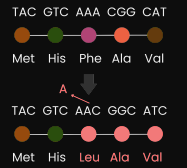
Explain how mutations can lead to production of shorter polypeptides
● Deletion or translocation → triplet(s) / codon(s) missing so amino acid(s) missing
● Substitution, addition, deletion, duplication, inversion or translocation → premature stop triplet / codon (doesn’t code for amino acids; terminates translation) so amino acids missing at end of polypeptide
What are stem cells?
Undifferentiated / unspecialised cells capable of:
1. Dividing (by mitosis) to replace themselves indefinitely
2. Differentiating into other types of (specialised) cells
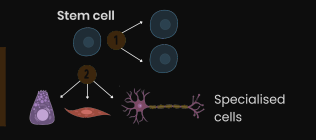
Describe how stem cells become specialised during development
● Stimuli lead to activation of some genes
● So mRNA is transcribed only from these genes and then translated to form proteins
● These proteins modify cells permanently and determine cell structure / function
Describe totipotent cells
● Occur for a limited time in early mammalian embryos
● Can divide AND differentiate into any type of body cell (including extra-embryonic cells eg. placenta)
Describe pluripotent cells
● Found in mammalian embryos (after first few cell divisions)
● Can divide AND differentiate into most cell types (every cell type in the body but not placental cells)

Describe multipotent cells
● Found in mature mammals
● Can divide AND differentiate into a limited number of cell types
Example: multipotent cells in bone marrow can divide and differentiate into different types of blood cell

Describe unipotent cells, using an example
● Found in mature mammals
● Can divide AND differentiate into just one cell type
Example: unipotent cells in the heart can divide and differentiate
into cardiomyocytes (cardiac muscle cells)
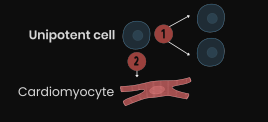
Explain how stem cells can be used in the treatment of human disorders
● Transplanted into patients to divide in unlimited numbers
● Then differentiate into required healthy cells (to replace faulty / damaged cells)
Examples:
● Potential treatment of Type 1 diabetes by creating healthy islet cells that produce insulin
● Bone marrow stem cell transplant for sickle cell disease / blood cancers
1. Destroy patient’s bone marrow before treatment → so no faulty cells are produced
2. Transplant stem cells from healthy person → divide and differentiate into healthy cells
Explain how induced pluripotent stem (iPS) cells are produced
1. Obtain adult somatic (body) cells (non-pluripotent cells or fibroblasts) from patient
2. Add specific protein transcription factors associated with pluripotency to cells so they express genes associated with pluripotency (reprogramming)
○ Transcription factors attach to promoter regions of DNA, stimulating or inhibiting transcription
3. Culture cells to allow them to divide by mitosis
Once made, iPS cells can divide and differentiate into healthy cells to be transplanted into the same patient
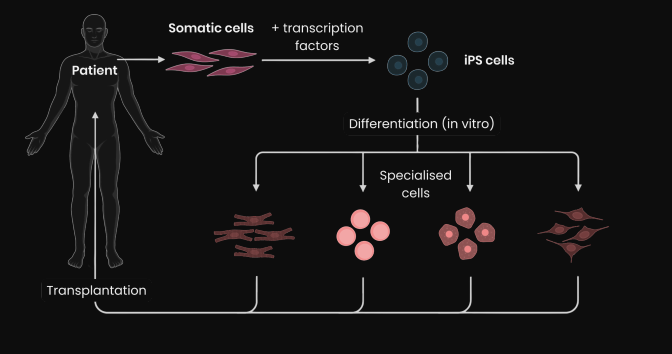
Evaluate the use of stem cells in treating human disorders
For :
✓ Can divide and differentiate into required healthy cells, so could relieve human suffering by saving lives and improving quality of life
✓ Embryos are often left over from IVF and so would otherwise be destroyed
✓ iPS cells unlikely to be rejected by patient’s immune system as made with patient’s own cells
✓ iPS cells can be made without destruction of embryo and adult can give permission
Against:
X Ethical issues with embryonic stem cells as obtaining them requires destruction of an embryo and potential life (embryo cannot consent)
X Immune system could reject cells and immunosuppressant drugs are required
X Cells could divide out of control, leading to formation of tumours / cancer
What are transcription factors?
● Proteins which regulate (stimulate or inhibit) transcription of specific target genes in eukaryotes
● By binding to a specific DNA base sequence on a promoter region
Describe how transcription can be regulated using transcription factors
1. Transcription factors move from cytoplasm to nucleus
2. Bind to DNA at a specific DNA base sequence on a promoter region (before / upstream of target gene)
3. This stimulates or inhibits transcription (production of mRNA) of target gene(s) by helping or preventing RNA polymerase binding

Explain how oestrogen affects transcription
1. Oestrogen is a lipid-soluble steroid hormone so diffuses into cell across the phospholipid bilayer
2. In cytoplasm, oestrogen binds to its receptor, an inactive transcription factor, forming an oestrogen-receptor complex
3. This changes the shape of the inactive transcription factor, forming an active transcription factor
4. The complex diffuses from cytoplasm into the nucleus
5. Then binds to a specific DNA base sequence on the promoter region of a target gene
6. Stimulating transcription of target genes forming mRNA by helping RNA polymerase to bind
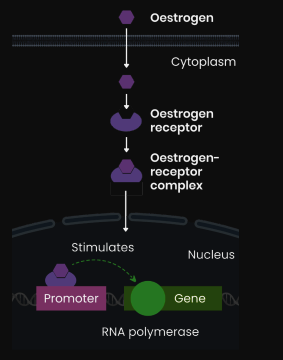
Explain why oestrogen only affects target cells
Other cells do not have oestrogen receptors
Describe what is meant by epigenetics
● Heritable changes in gene function / expression without changes to the base sequence of DNA
● Caused by changes in the environment (eg. diet, stress, toxins)
Describe what is meant by epigenome
All chemical modification of DNA and histone proteins - methyl groups on DNA and acetyl groups on histones
Summarise the epigenetic control of gene expression in eukaryotes
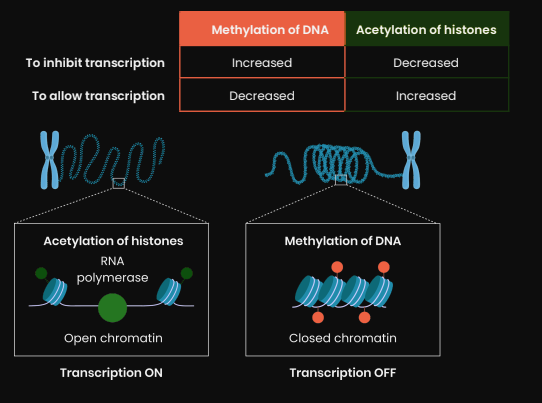

Explain how increased methylation can inhibit transcription
1. Increased methylation of DNA - methyl groups added to cytosine bases in DNA
2. So nucleosomes (DNA wrapped around histone) pack more tightly together
3. Preventing transcription factors and RNA polymerase binding to promoter

Explain how decreased acetylation can inhibit transcription
1. Decreased acetylation of histones increases positive charge of histones
2. So histones bind DNA (negatively charged) more tightly
3. Preventing transcription factors and RNA polymerase binding to promoter
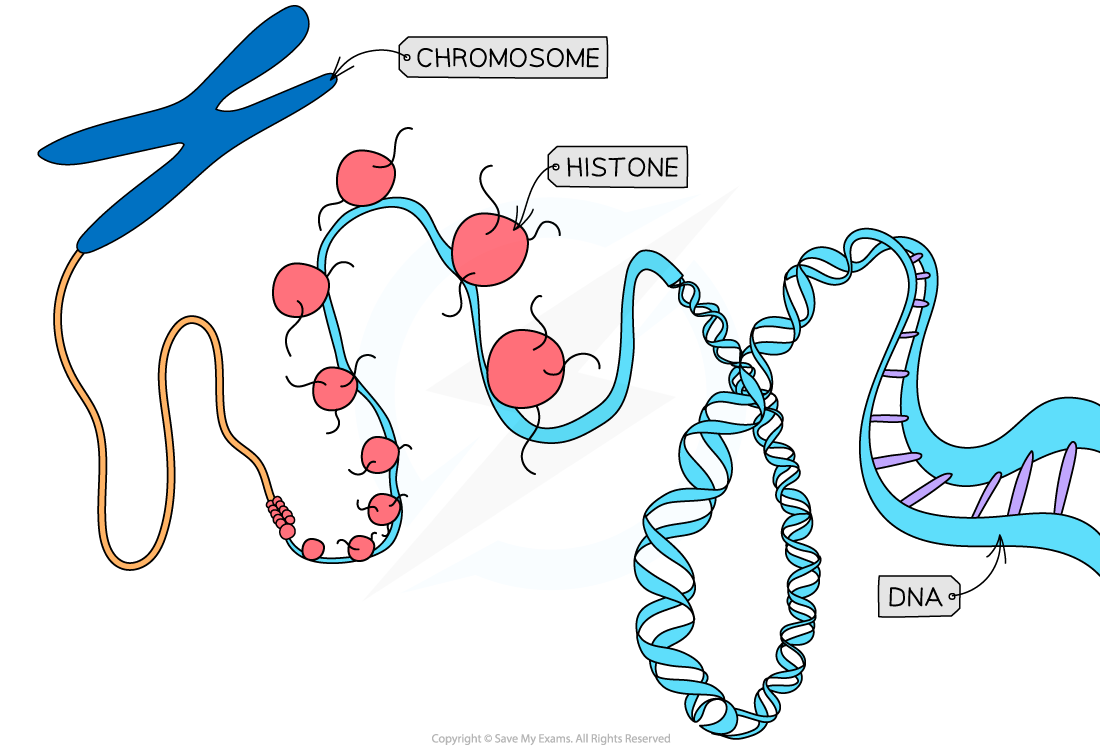
Explain the relevance of epigenetics on disease development and treatment
● Environmental factors (eg. diet, stress, toxins) can lead to epigenetic changes
● These can stimulate / inhibit expression of certain genes that can lead to disease development
○ Increased methylation of DNA OR decreased acetylation of histones inhibits transcription
○ Decreased methylation of DNA OR increased acetylation of histones stimulates transcription
● Diagnostic tests can be developed that detect these epigenetic changes before symptoms present
● Drugs can be developed to reverse these epigenetic changes
What is RNA interference (RNAi)?
● Inhibition of translation of mRNA produced from target genes, by RNA molecules eg. siRNA, miRNA
● This inhibits expression of (silencing) a target gene
-This happens in eukaryotes and some prokaryotes
(Biological process where small RNA molecules, called small interfering RNAs (siRNAs), bind to and inhibit the translation of complementary messenger RNA (mRNA) molecules, effectively silencing gene expression.)

Describe the regulation of translation by RNA interference
1. Small interfering RNA (siRNA) or micro-RNA (miRNA) is incorporated into/ binds to a protein, forming an RNA-induced silencing complex (RISC)
○ siRNA synthesised as double-stranded RNA → 1 strand incorporated
○ miRNA synthesised as a double-stranded hairpin bend of RNA → both strands incorporated
2. Single-stranded miRNA / siRNA within RISC binds to target mRNA with a complementary base sequence
3. This leads to hydrolysis of mRNA into fragments which are then degraded OR prevents ribosomes binding
4. Reducing / preventing translation of target mRNA into protein
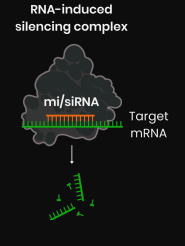
Describe how tumours and cancers form
● Mutations in DNA / genes controlling mitosis can lead to uncontrolled cell division
● Tumour formed if this results in mass of abnormal cells
○ Malignant tumour = cancerous, can spread by metastasis
○ Benign tumour = non-cancerous
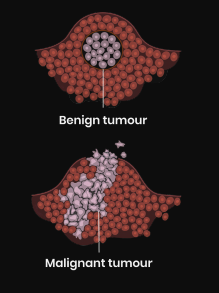
Compare the main characteristics of benign and malignant tumours
Benign tumours:
Usually grow slowly (cells divide less often)
Cells are well differentiated / specialised
Cells have normal, regular nuclei
Well defined borders and often surrounded by a capsule so do not invade surrounding tissue
Do not spread by metastasis (as cell adhesion molecules stick cells together)
Can normally be removed by surgery and they rarely return
Malignant tumours:
Usually grow faster (cells divide more often)
Cells become poorly differentiated / unspecialised
Cells have irregular, larger / darker nuclei
Poorly defined borders and not encapsulated so can invade surrounding tissues (growing projections)
Spread by metastasis - cells break off and spread to other parts of the body, forming secondary tumours (due to lack of adhesion molecules)
Can normally be removed by surgery combined with radiotherapy / chemotherapy but they often return
Describe the function of tumour suppressor genes
Code for proteins that:
● Inhibit / slow cell cycle (eg. if DNA damage detected)
● OR cause self-destruction (apoptosis) of potential tumour cells (eg. if damaged DNA can’t be repaired)
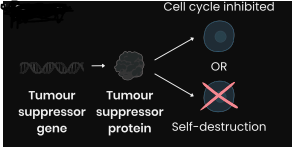
Explain the role of tumour suppressor genes in the development of tumours
● Mutation in DNA base sequence → production of non-functional protein
○ By leading to change in amino acid sequence which changes protein tertiary structure
● Decreased histone acetylation OR increased DNA methylation → prevents production of protein
○ By preventing binding of RNA polymerase to promoter region, inhibiting transcription
● Both lead to uncontrolled cell division (cell division cannot be slowed)

Describe the function of (proto-)oncogenes
Code for proteins that stimulate cell division (eg. through involvement in signalling pathways that control cell responses to growth factors)

oncogene
(An oncogene is a mutated / abnormally expressed form of the corresponding proto-oncogene)
Explain the role of oncogenes in the development of tumours
● Mutation in DNA base sequence → overproduction of protein OR permanently activated protein
○ By leading to change in amino acid sequence which changes protein tertiary structure
● Decreased DNA methylation OR increased histone acetylation → increases production of protein
○ By stimulating binding of RNA polymerase to promoter region, stimulating transcription
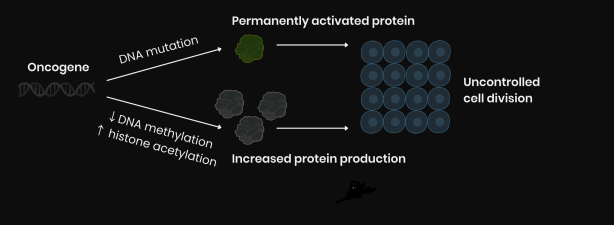
Suggest why tumours require mutations in both alleles of a tumour suppressor gene but only one allele of an oncogene
● One functional allele of a tumour suppressor gene can produce enough protein to slow the cell cycle OR cause self-destruction of potential tumour cells → cell division is controlled
● One mutated oncogene allele can produce enough protein to lead to rapid / uncontrolled cell division
Explain the relevance of epigenetics in cancer treatment
Drugs could reverse epigenetic changes that caused cancer, preventing uncontrolled cell division. For example:
● Increasing DNA methylation OR decreasing histone acetylation of oncogene
○ To inhibit transcription / expression
● Decreasing DNA methylation OR increasing histone acetylation of tumour suppressor gene
○ To stimulate transcription / expression
Explain the role of increased oestrogen concentrations in the development of some (oestrogen receptor-positive) breast cancers
1. Some breast cancers cells have oestrogen receptors, which are inactive transcription factors
2. If oestrogen concentration is increased, more oestrogen binds to oestrogen receptors, forming more oestrogen-receptor complexes which are active transcription factors
3. These bind to promoter regions of genes that code for proteins stimulating cell division
4. This increases transcription / expression of these genes, increasing the rate of cell division
Suggest how drugs that have a similar structure to oestrogen help treat oestrogen receptor-positive breast cancers
● Drugs bind to oestrogen receptors (inactive transcription factors), preventing binding of oestrogen
● So no / fewer transcription factors bind to promoter regions of genes that stimulate the cell cycle
Define ‘genome’ and ‘proteome’
Genome: The complete set of genes in a cell
Proteome: The full range of proteins that a cell can produce (coded for by the cell’s DNA / genome)
What is genome sequencing and why is it important?
● Identifying the DNA base sequence of an organism’s genome
● So amino acid sequences of proteins that derive from an organism’s genetic code can be determined
-Sequencing projects have read the genomes of a range of organisms, including humans
Explain how determining the genome of a pathogen could allow vaccines to be developed
● Could identify the pathogen’s proteome
● So could identify potential antigens (proteins that stimulate an immune response) to use in the vaccine
Suggest some other potential applications of genome sequencing projects
● Identification of genes / alleles associated with genetic diseases / cancers
○ New targeted drugs / gene therapy can be developed
○ Can screen patients, allowing early prevention / personalised medicine
● Identification of species and evolutionary relationships
Explain why the genome cannot be directly translated into the proteome in complex organisms
● Presence of non-coding DNA (eg. introns within genes do not code for polypeptides)
● Presence of regulatory genes (which regulate expression of other genes, eg. by coding for miRNA)
Describe how sequencing methods are changing
● They have become automated (so are faster, more cost-effective and can be done on a larger scale)
● They are continuously updated
What is recombinant DNA technology?
Transfer of DNA fragments from one organism or species, to another
Explain why transferred DNA can be translated within cells of recipient (transgenic) organisms
1. Genetic code is universal
2. Transcription and translation mechanisms are universal
Describe how DNA fragments can be produced using restriction enzymes
1. Restriction enzymes cut DNA at specific base ‘recognition sequences’ either side of the desired gene
○ Shape of recognition site complementary to active site
2. Many cut in a staggered fashion forming ‘sticky ends’ (single stranded overhang)
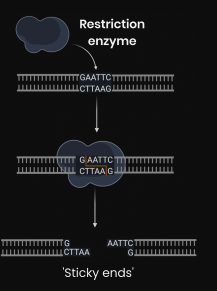
Describe how DNA fragments can be produced from mRNA
1. Isolate mRNA from a cell that readily synthesises the protein coded for by the desired gene
2. Mix mRNA with DNA nucleotides and reverse transcriptase → reverse transcriptase uses mRNA as a template to synthesise a single strand of complementary DNA (cDNA)
3. DNA polymerase can form a second strand of DNA using cDNA as a template
Suggest two advantages of obtaining genes from mRNA rather than directly from the DNA removed from cells
● Much more mRNA in cells making the protein than DNA → easily extracted
● In mRNA, introns have been removed by splicing (in eukaryotes) whereas DNA contains introns
○ So can be transcribed & translated by prokaryotes who can’t remove introns by splicing
Describe how fragments of DNA can be produced using a gene machine
● Synthesises fragments of DNA quickly & accurately from scratch without need for a DNA template
○ Amino acid sequence of protein determined, allowing base sequence to be established
● These do not contain introns so can be transcribed & translated by prokaryotes
Name an in vitro and in vivo technique used to amplify DNA fragments
● In vitro (outside a living organism) - polymerase chain reaction
● In vivo (inside a living organism) - culturing transformed host cells eg. bacteria
Explain how DNA fragments can be amplified by PCR
Reaction mixture: DNA fragment, DNA polymerase (eg. taq polymerase), primers and DNA nucleotides
1. Mixture heated to 95oC:
● This separates DNA strands
● Breaking hydrogen bonds between bases
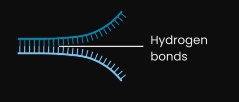
2. Mixture cooled to 55oC:
● This allows primers to bind to DNA fragment template strand
● By forming hydrogen bonds between complementary bases

3. Mixture heated to 72oC:
● Nucleotides align next to complementary exposed bases
● DNA polymerase joins adjacent DNA nucleotides, forming phosphodiester bonds
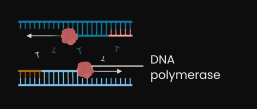
This cycle is repeated - in every cycle, the amount of DNA doubles causing an exponential increase (2n)

Explain the role of primers in PCR
● Primers are short, single stranded DNA fragments
● Complementary to DNA base sequence at edges of region to be copied / start of desired gene
● Allowing DNA polymerase to bind to start synthesis (can only add nucleotides onto pre-existing 3’ end)
● Two different primers (forward and reverse) are required (as base sequences at ends are different)
Suggest one reason why DNA replication eventually stops in PCR
There are a limited number of primers and nucleotides which are eventually used up
Summarise the steps involved in amplifying DNA fragments in vivo
1. Add promoter and terminator regions to DNA fragments
2. Insert DNA fragments & marker genes into vectors (eg. plasmids) using restriction enzymes and ligases
3. Transform host cells (eg. bacteria) by inserting these vectors
4. Detect genetically modified (GM) / transformed cells / organisms by identifying those containing the marker gene (eg. that codes for a fluorescent protein)
5. Culture these transformed host cells, allowing them to divide and form clones
Following this, DNA can be extracted from the host cells if needed or the host cells can produce a protein coded for by a gene in the DNA fragment
Explain why promoter and terminator regions are added to DNA fragments that are used to genetically modify organisms
Promoter regions:
● Allow transcription to start by allowing RNA polymerase to bind to DNA
● Can be selected to ensure gene expression happens only in specific cell types
○ Eg. in gland cells of a mammal so the protein can be easily harvested
Terminator regions:
● Ensure transcription stops at the end of a gene, by stopping RNA polymerase
What are the role of vectors in recombinant DNA technology?
To transfer DNA into host cells / organisms eg. plasmids or viruses (bacteriophage)
Explain the role of enzymes in inserting DNA fragments into vectors
1. Restriction endonucleases / enzymes cut vector DNA
○ Same enzyme used that cut the gene out so vector DNA & fragments have ‘sticky ends’ that can join by complementary base pairing
2. DNA ligase joins DNA fragment to vector DNA
○ Forming phosphodiester bonds between adjacent nucleotides
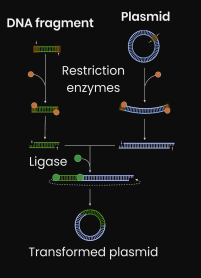
Describe how host cells are transformed using vectors
● Plasmids enter cells (eg. following heat shock in a calcium ion solution)
● Viruses inject their DNA into cells which is then integrated into host DNA
Explain why marker genes are inserted into vectors
● To allow detection of genetically modified / transgenic cells / organisms
○ If marker gene codes for antibiotic resistance, cells that survive antibiotic exposure = transformed
○ If marker gene codes for fluorescent proteins, cells that fluoresce under UV light = transformed
● As not all cells / organisms will take up the vector and be transformed
Suggest how recombinant DNA technology can be useful
Medicine:
● GM bacteria produce human proteins (eg. insulin for type 1 diabetes) → more ethically acceptable than using animal proteins and less likely to cause allergic reactions
● GM animals / plants produce pharmaceuticals (‘pharming’) → cheaper
● Gene therapy
Agriculture:
● GM crops resistant to herbicides → only weeds killed when crop sprayed with herbicide
● GM crops resistant to insect attack → reduce use of insecticide
● GM crops with added nutritional value (eg. Golden rice has a precursor of vitamin A)
● GM animals with increased growth hormone production (eg. Salmon)
Industry:
● GM bacteria produce enzymes used in industrial processes and food production
Describe gene therapy
● Introduction of new DNA into cells, often containing healthy / functional alleles
● To overcome effect of faulty / non-functional alleles in people with genetic disorders eg. cystic fibrosis
(Note - if body cells are altered, changes are not heritable. Gene therapy in gametes is currently illegal.)
Suggest some issues associated with gene therapy
● Effect is short lived as modified cells (eg. T cells) have a limited lifespan → requires regular treatment
● Immune response against genetically modified cells or viruses due to recognition of antigens
● Long term effect not known - side effects eg. could cause cancer
○ DNA may be inserted into other genes, disrupting them → interfering with gene expression
Suggest why humanitarians might support recombinant DNA technology
● GM crops increase yields → increased global food production → reduced risk of famine / malnutrition
● Gene therapy has potential to cure many genetic disorders
● ‘Pharming’ makes medicines available to more people as medicines cheaper
Suggest why environmentalists and anti-globalisation activists might oppose recombinant DNA technology
● Recombinant DNA may be transferred to other plants → potential herbicide resistant ‘superweeds’
● Potential effects on food webs eg. affect wild insects → reduce biodiversity
● Large biotech companies may control the technology and own patents
What are DNA probes?
● Short, single stranded pieces of DNA
● With a base sequence complementary to bases on part of a target allele / region
● Usually labelled with a fluorescent or radioactive tag for identification
Suggest why DNA probes are longer than just a few bases
● A sequence of a few bases would occur at many places throughout the genome
● Longer sequences are only likely to occur in target allele
What is DNA hybridisation?
● Binding of a single stranded DNA probe to a complementary single strand of DNA
● Forming hydrogen bonds / base pairs

Explain how genetic screening can be used to locate specific alleles of genes
1. Extract DNA and amplify by PCR
2. Cut DNA at specific base sequences (either side of target gene) using restriction enzymes
3. Separate DNA fragments / alleles (according to length) using gel electrophoresis
4. Transfer to a nylon membrane and treat to form single strands with exposed bases
5. Add labelled DNA probes which hybridise / bind with target alleles (& wash to remove unbound probe)
6. To show bound probe, expose membrane to UV light if a fluorescently labelled probe was used OR use autoradiography (expose to X-ray film) if a radioactive probe was used
What is gel electrophoresis?
● A method used to separate nucleic acid (DNA / RNA) fragments OR proteins
● According to length / mass (number of bases / amino acids) AND charge (DNA is negatively charged due to phosphate groups and protein charge varies based on amino acid R groups)
Explain how gel electrophoresis can be used to separate DNA fragments
1. DNA samples loaded into wells in a porous gel and covered in buffer solution (which conducts electricity)
2. Electrical current passed through → DNA is negatively charged so moves towards positive electrode
3. Shorter DNA fragments travel faster so travel further
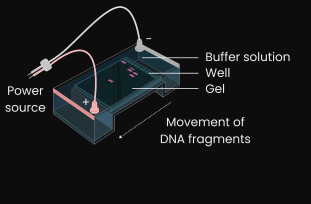
How can data showing results of gel electrophoresis be interpreted?
● Run a standard with DNA fragments / proteins of known lengths under the same conditions
● Compare to position of unknown DNA fragments / proteins to estimate their size
● Shorter DNA fragments/ proteins travel further / faster
Describe examples of the use of labelled DNA probes
● Screening patients for heritable conditions (eg. cystic fibrosis)
● Screening patients for drug responses (some alleles code for enzymes involved in drug metabolism that enable better responses to certain drugs)
● Screening patients for health risks (some alleles predispose patients eg. to high blood cholesterol)
Describe the role of a genetic counsellor
1. Explain results of genetic screening, including consequences of a disease
2. Discuss treatments available for genetic condition
3. Discuss lifestyle choices / precautions that might reduce risk of a genetic condition developing eg. regular screening for tumours or a mastectomy
4. Explain probability of condition / alleles being passed onto offspring → enable patients to make informed decisions about having children
What is personalised medicine?
What is personalised medicine?
● Medicine tailored to an individual's genotype / DNA
● Increasing effectiveness of treatment eg. by identifying the particular mutation / allele causing cancer and treating it with tailored drugs
Evaluate the screening of individuals for genetically determined conditions and drug responses
For:
✓ Some people could be heterozygous / carriers (eg. in families with a history of a disease)
✓ Can enable these people to make lifestyle choices to reduce chances of diseases
developing, to prevent suffering / death
✓ Allows people to make informed decisions about having their own biological children
✓ Allows use of personalised medicines, increasing effectiveness of treatment
Against:
X Screening for incurable diseases or diseases that develop later in life (where nothing positive can be done in response) may lead to depression
X May cause undue stress if patient does not develop the disease
X Could lead to discrimination by insurance companies / employers
X Many diseases are rare
X Many are caused by many genes so would need too many probes (expensive)
What are variable number tandem repeats (VNTRs)?
● Repeating sequences of nucleotides / bases (eg. GATA)
● Found within non-coding sections of DNA at many sites throughout an organism’s genome
Why are VNTRs useful in genetic fingerprinting?
● Probability of two individuals having the same VNTRs is very low
● As an organism’s genome contains many VNTRs and lengths at each loci differ between individuals
Explain how genetic fingerprinting can be used to analyse DNA fragments
1. Extract DNA from sample (eg. blood cells) and amplify by PCR
2. Cut DNA at specific base sequences / recognition sites (either side of VNTRs) using restriction enzymes
3. Separate VNTR fragments according to length using gel electrophoresis (shorter ones travel further)
4. Transfer to a nylon membrane and treat to form single strands with exposed bases
5. Add labelled DNA probes which hybridise / bind with complementary VNTRs (& wash to remove
unbound probe)
6. To show bound probe, expose membrane to UV light if a fluorescently labelled probe was used OR use autoradiography (expose to X-ray film) if a radioactive probe was used
Compare and contrast genetic fingerprinting with genetic screening
● Both use PCR to amplify DNA sample
● Both use electrophoresis to separate DNA fragments
● Both use labelled DNA probes to visualise specific DNA fragments
● Genetic fingerprinting analyses VNTRs whereas genetic screening analyses specific alleles of a gene
Explain how genetic fingerprinting can be used to determine genetic relationships
● More closely related organisms have more similar VNTRs, so more similarities in genetic fingerprints
● Paternity testing - father should share around 50% of VNTRs / bands with child (due to inheritance)
Explain how genetic fingerprinting can be used to determine genetic variability within a population
Differences in VNTRs arise from mutations, so more differences show greater diversity within a population
Explain the use of genetic fingerprinting in the fields of forensic science,
● Compare genetic fingerprint of suspects to genetic fingerprint of DNA at crime scene
● If many bands match, the suspect was likely present at the crime scene
Explain the use of genetic fingerprinting in the fields of Medical diagnosis,
● Some VNTR patterns are associated with an increased risk of certain genetic disorders eg. Huntington’s
Explain the use of genetic fingerprinting in the fields of Animal and plant breeding,
● Shows how closely related 2 individuals are, so that inbreeding can be avoided
● Breed pairs with dissimilar genetic fingerprints